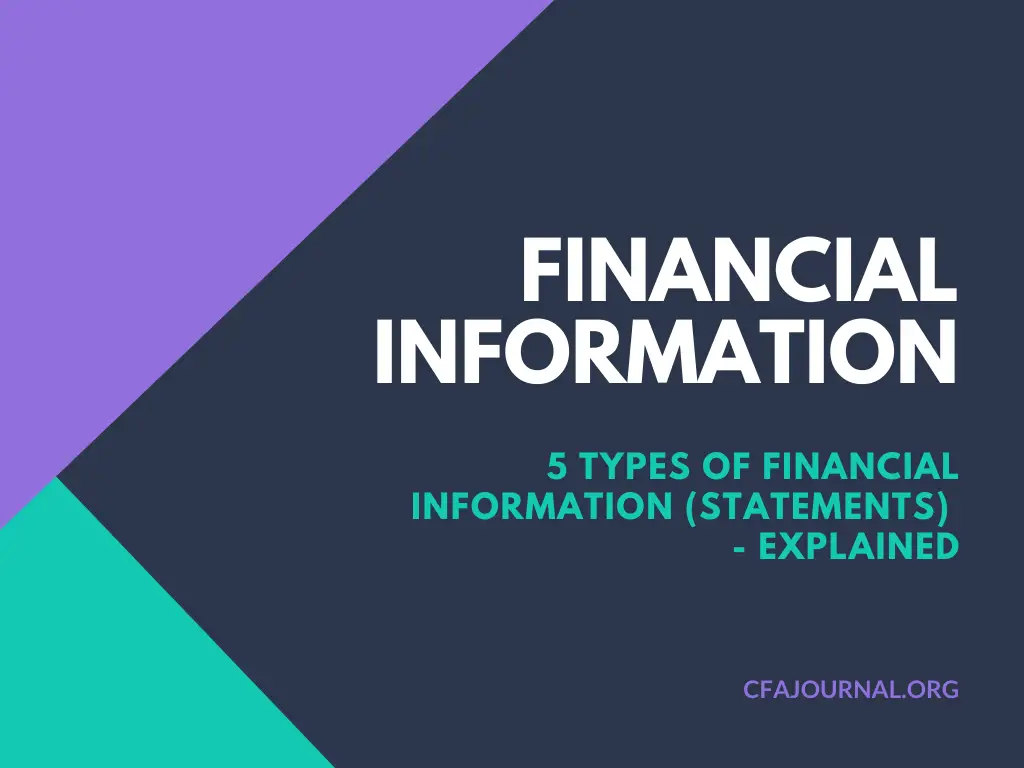Financial information is data about financial transactions about a person or business. Financial information includes payment histories, credit card numbers, credit ratings by third parties, financial statements, etc.
Financial information is used by investment companies, creditors, lenders, and management to evaluate an entity.
While using financial information, the security of the data should be ensured because misuse of it could happen by third parties.
The financial statement helps analyze a company’s financial position and provides a picture of the performance of a business.

The five main types of financial statements are the income statement, balance sheet, statement of cash flows, and statement of changes in equity and noted to financial statements.
They are described as follows:
1) Income Statement
An income statement, also known as a profit loss statement, discloses information about a company’s financial performance for the entire reporting period. The key elements of the income statement are revenue and expenses.
A business’s day-to-day expenses and income from its business are recorded in the income statement.
A business earns income by selling its products or services to customers and incurs expenses like salaries, rent, water bills, electricity bills, telephone bills, insurance, marketing, advertising, stationery costs, etc.
An income statement can be prepared for a month, quarter, or year. An accurate and detailed income statement is required to attract investors.
Generally, an income statement is an initial document a lender or investor may want to see.
The income statement shows a business’s performance by providing information about revenue and spending that could help make informed decisions.
2) Balance Sheet
The balance sheet shows a company’s value by displaying all assets, liabilities, and equities.
Its focal point is the accounting equation by disclosing the financial resources owned by an entity and the liabilities of that entity.
The asset part of the balance sheet should be equal to the liability plus equity part.
The balance sheet can show a company’s business value for a certain period. The asset side of the balance sheet has cash and cash equivalents, plant and equipment, inventory, accounts receivables, and marketable securities items.
The liabilities and equity side of the balance sheet have accounts payable, long-term debt, unearned revenue, paid-up capital, and retained earnings.
The Balance Sheet Formula is: Assets = (Libilitites + Equity)
It is also called accounting equation.
3) Statement of Cash Flows
The statement of cash flow records all-cash transactions that happen over a period in an organization. It shows cash inflows and outflows over a projected period and doesn’t show income.
A company generates cash from operating, investment, and financing activities. A cash flow statement shows the solvency of a business to investors and creditors.
Many organizations fail due to cash flow issues. A forecasted cash flow statement can help a business predict possible cash flow issues and minimize their impact.
This statement shows how much a firm needs to borrow and when it will need to pay the loans.
The difference between a cash flow statement and a forecasted cash flow statement is that a cash flow statement represents already incurred transactions, and a forecasted cash flow statement predicts future cash transactions.
4) Statement of Changes in Equity
Statement of equity changes, also known as Statement of retained earnings, shows all the changes in the equity during the reporting period.
These changes include the purchase of shares, net profit or loss during the period, dividend payments, effects of changes in the accounting policy, revaluation surpluses, etc.
The statement of retained earnings provides a picture of the changes in retained earnings from one period to another.
5) Financial Footnotes
Financial footnotes provide explanations about accounting practices and other information for the elements of financial statements.
Footnotes provide qualitative information that helps better understand a company’s true financial performance by explaining significant operational and financial results.
Footnotes identify and explain significant accounting policies a company chooses to formulate its financial information. The financial statement in an annual report should be clean and simple to understand.
For this purpose, footnotes provide explanations and other calculations. Information like errors in previous accounting statements, any legal cases in the company are involved, and other important disclosures are mentioned in the footnotes.
Footnotes should be transparent as much as possible without harmfully disclosing any sensitive information about the company.
It can be stated in the end that financial information is very much crucial for decision-making.
Financial statements are written records of a business’s financial condition. Analyzing the company’s financial information will allow us to make strategic decisions for long-term growth.

